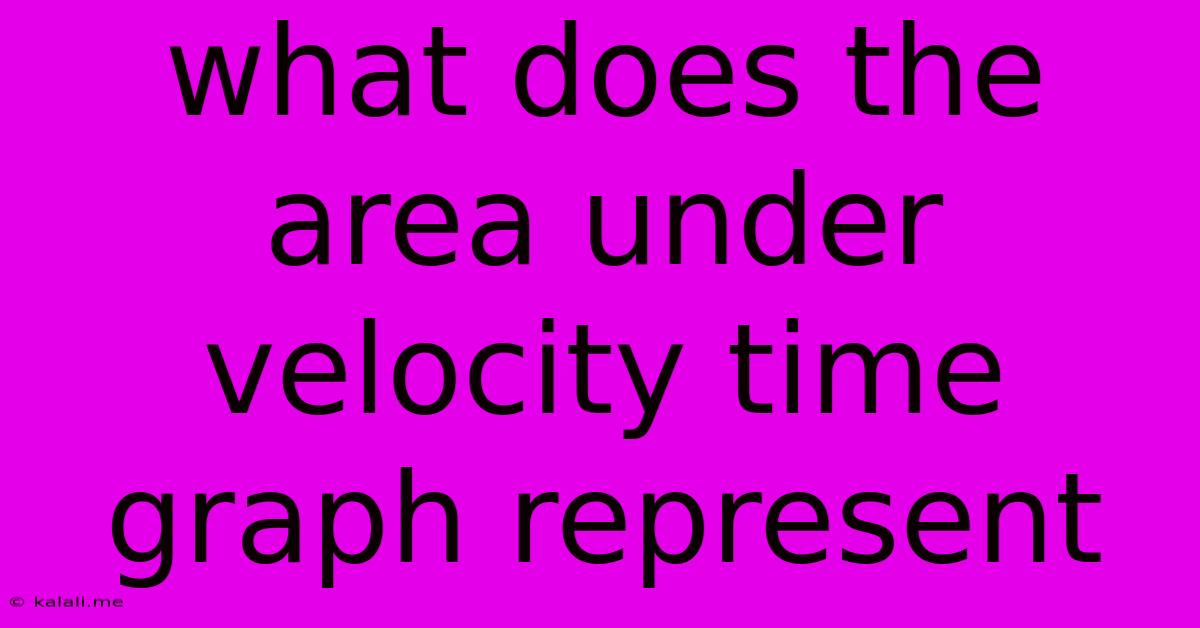What Does The Area Under Velocity Time Graph Represent
Kalali
Jun 14, 2025 · 3 min read

Table of Contents
What Does the Area Under a Velocity-Time Graph Represent?
The area under a velocity-time graph represents the displacement of an object. This is a fundamental concept in physics and understanding it is crucial for interpreting motion. This article will explain why this is the case, explore different scenarios, and offer practical examples to solidify your understanding.
Understanding Velocity and Displacement
Before diving into the graph, let's define our key terms. Velocity is the rate of change of an object's position, incorporating both speed and direction. Displacement, on the other hand, is the overall change in an object's position from its starting point to its ending point – a vector quantity considering both magnitude and direction. Distance, in contrast, is a scalar quantity, only considering the magnitude of the path traveled.
The Calculus Connection: Velocity as the Derivative of Displacement
In calculus, velocity is defined as the derivative of displacement with respect to time. This means that velocity tells us how quickly the displacement is changing at any given instant. Conversely, displacement is the integral of velocity with respect to time. This integral is graphically represented by the area under the velocity-time curve.
Visualizing the Area Under the Curve
Imagine a simple velocity-time graph showing constant velocity. The graph forms a rectangle. The area of this rectangle is calculated as base × height, where the base represents the time interval and the height represents the velocity. This directly gives you the displacement: velocity multiplied by time.
- Constant Velocity: A straight horizontal line indicates constant velocity. The area is a simple rectangle, easily calculated.
- Changing Velocity: A curved line indicates changing velocity (acceleration or deceleration). The area under the curve becomes more complex but still represents the total displacement. This requires more advanced mathematical techniques like integration to accurately calculate, but the principle remains the same. Approximations can be made using methods like dividing the area into smaller rectangles or trapezoids.
- Negative Velocity: If the velocity is negative (the object is moving in the opposite direction), the area under the curve is also negative, indicating a negative displacement (movement in the opposite direction of the initial movement).
Practical Examples
- A car traveling at a constant 60 mph for 2 hours: The area under the velocity-time graph (a rectangle with height 60 mph and base 2 hours) represents a displacement of 120 miles.
- A ball thrown vertically upwards: The velocity starts positive, decreases to zero at its highest point, and then becomes negative as it falls back down. The area under the curve, considering both positive and negative portions, will represent the final displacement (which will be zero if it lands at the same position from where it was thrown).
- A runner sprinting: The velocity-time graph will likely show a curve, representing acceleration at the start and perhaps deceleration at the end. The total area under this curve represents the runner's total displacement during the sprint.
Conclusion
In summary, the area under a velocity-time graph represents the displacement of an object. This holds true whether the velocity is constant or changing, positive or negative. Understanding this relationship is essential for interpreting motion and solving problems in kinematics. The concept links graphical representation with fundamental calculus principles, offering a powerful tool for analyzing motion.
Latest Posts
Latest Posts
-
Intellectual Disabilities Are Characterized By Significant Limitations Both In
Jun 15, 2025
-
L I M In P India
Jun 15, 2025
-
A Chisel Used To Cut V Grooves And Square Corners
Jun 15, 2025
-
What Is The Least Common Multiple Of 6 And 24
Jun 15, 2025
-
What Is The Smallest Unit Of Data In Computer
Jun 15, 2025
Related Post
Thank you for visiting our website which covers about What Does The Area Under Velocity Time Graph Represent . We hope the information provided has been useful to you. Feel free to contact us if you have any questions or need further assistance. See you next time and don't miss to bookmark.